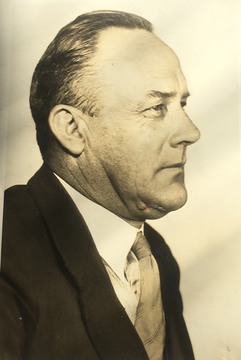BYRON, Thomas John
| Service Number: | 3467 |
|---|---|
| Enlisted: | Not yet discovered |
| Last Rank: | Private |
| Last Unit: | 17th Infantry Battalion |
| Born: | Sydney, New South Wales, Australia, 14 December 1891 |
| Home Town: | Not yet discovered |
| Schooling: | St Joseph's Sydney, New South Wales, Australia |
| Occupation: | Not yet discovered |
| Died: | Sydney, New South Wales, Australia, 12 March 1943, aged 51 years, cause of death not yet discovered |
| Cemetery: | Not yet discovered |
| Memorials: |
World War 1 Service
| 20 Dec 1915: | Involvement Private, 3467, 17th Infantry Battalion, --- :embarkation_roll: roll_number: '12' embarkation_place: Sydney embarkation_ship: HMAT Aeneas embarkation_ship_number: A60 public_note: '' | |
|---|---|---|
| 20 Dec 1915: | Embarked Private, 3467, 17th Infantry Battalion, HMAT Aeneas, Sydney |
Help us honour Thomas John Byron's service by contributing information, stories, and images so that they can be preserved for future generations.
Add my storyBiography contributed by Samantha Barton
Thomas John Byron was born in Sydney, 1891, to second-generation Irish immigrant parents. He attended St Joseph’s until the age of fifteen at which point he began to work as a stock hand on the family property. In 1915, Byron enlisted in the 17th Battalion of the AIF at the age of 23, embarking for Egypt in December 1915 and after a period of training in Alexandria, proceeding to France in late March 1916. Within a month, Byron was wounded and hospitalised, but returned to duty within two weeks.
On the 22nd of June 1916, Byron was stationed in France during the Battle of Verdun, when the Germans used poisonous phosphene gas and heavy artillery as they resumed their offensive against the allied forces. During the attack, Byron, ventured into the line of fire to rescue his unconscious mate, who had been wounded. Dragging his friend back behind the line exposed Byron to high levels of toxicity in the pockets of poisonous gas that lingered, as he panted and breathed deeply, struggling with the dead weight. Managing to stagger back against all odds with his mate, Byron was immediately brought in for shrapnel damage to both his arm and leg, coupled with untold lung damage. A field hospital in early July 1916 reported his condition as “unpromising”, and hence, he was shipped to England for care in the London military hospital at Bethnal Green.
For the next five months, Byron’s condition fluctuated from “improving” to “dangerously ill”. The shrapnel damage to his left arm and right leg had shattered the bone, and both needed to be amputated. Additionally, he had accrued serious lung damage, losing the use of one lung entirely, and suffering minor damage to the other. Despite this, his condition improved favourably, and in early 1917, after a six-month stint in hospital, he returned to Australia and was discharged from the Battalion.
Returning as a stock-hand and later working on the city desk of The Sun newspaper, Byron was setback by nothing, as he remained a keen cricketer - becoming a lifelong member of the Sydney Cricket Ground and of the Disabled Cricketers Association – and was still described as something of a larrikin and show-off by his later wife. Marrying Ada Ross, a daughter of Scottish immigrants in 1926, Byron had a son whom died in infancy, and a daughter, Joan Ross Byron whom he raised as the son he never had. Good friends with Sir Charles Kingsford Smith and Jack Kingsman, he was an avid hunter and deep-sea fisher with the two, and ensured his daughter was always involved in his activities, irregardless of the traditional role of women.
Thomas Byron passed away on the 12th of March 1943, having greatly exceeded the life expectancy of the soldier he’d once been, wounded and dying in France.













